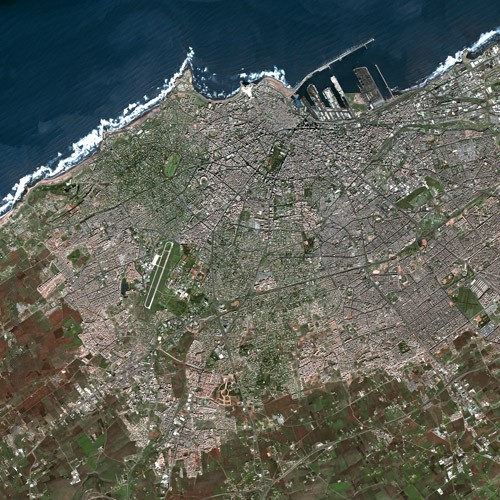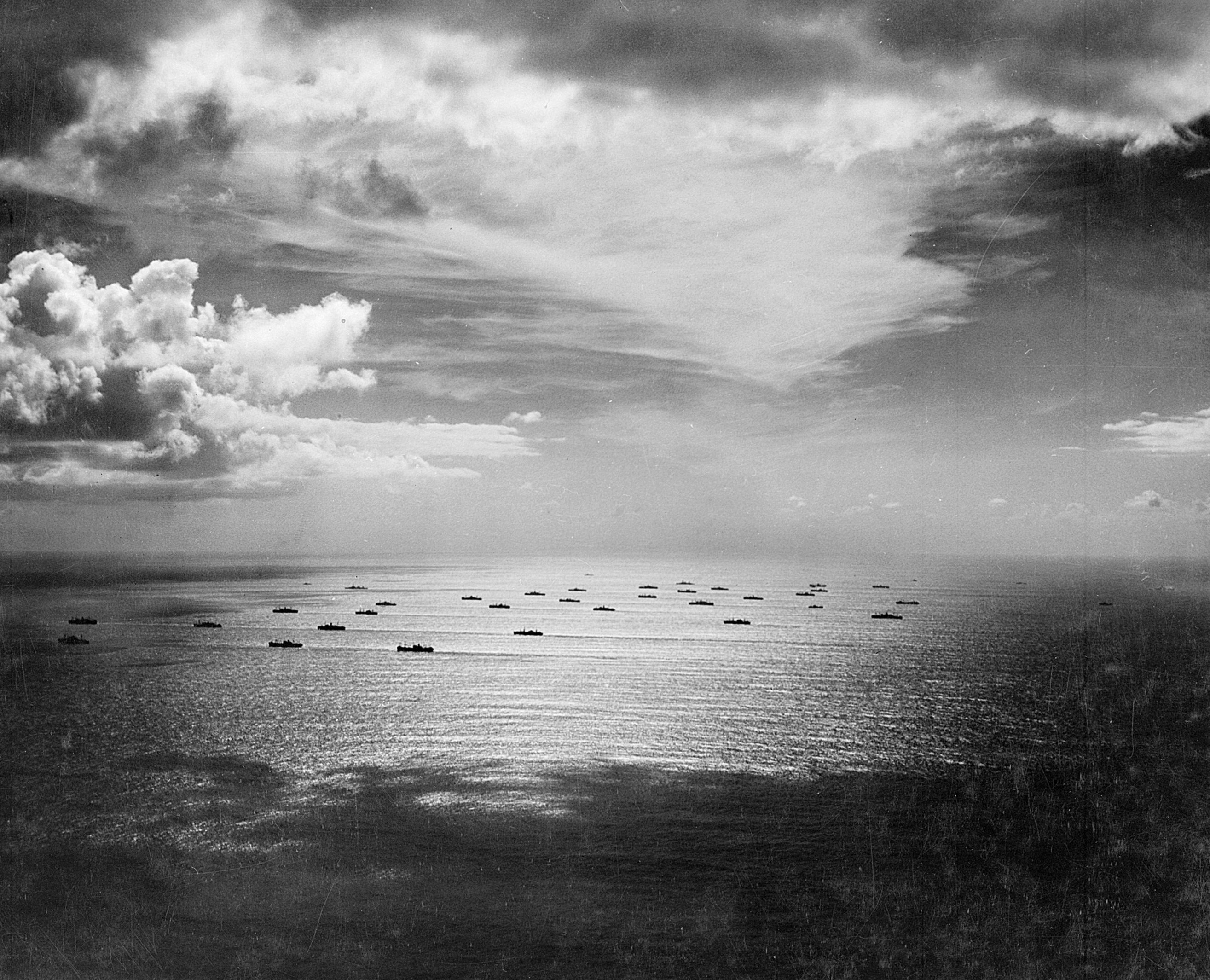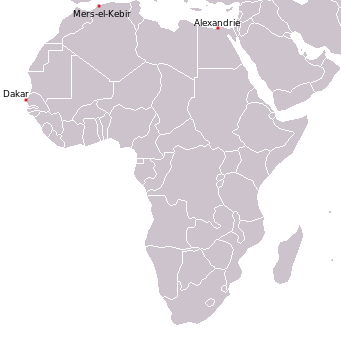|
Naval Battle Of Casablanca
The Naval Battle of Casablanca was a series of naval engagements fought between United States Navy, American ships covering the Operation Torch, invasion of North Africa and Vichy France, Vichy French ships defending the Neutrality (international relations), neutrality of French Morocco in accordance with the Second Armistice at Compiègne during World War II. The last stages of the battle consisted of operations by Nazi Germany, German U-boats which had reached the area the same day the French troops surrendered. Allied military planners anticipated an all-American force assigned to seize the Atlantic Ocean, Atlantic port city of Casablanca might be greeted as liberators. An invasion task force of 102 American ships carrying 35,000 American soldiers approached the Moroccan coast undetected under cover of darkness. French defenders interpreted the first contacts as a diversionary raid for a major landing in Algeria; and Germany regarded the surrender of six Moroccan Division (mili ... [...More Info...] [...Related Items...] OR: [Wikipedia] [Google] [Baidu] |
Operation Torch
Operation Torch (8 November 1942 – Run for Tunis, 16 November 1942) was an Allies of World War II, Allied invasion of French North Africa during the Second World War. Torch was a compromise operation that met the British objective of securing victory in North Africa while allowing American armed forces the opportunity to engage in the fight against Nazi Germany on a limited scale. It was the first mass involvement of US troops in the Mediterranean and Middle East theatre of World War II, European–North African Theatre, and saw the first major airborne assault carried out by the United States. While the French colonies were formally aligned with Germany via Vichy France, the loyalties of the population were mixed. Reports indicated that they might support the Allies. American General Dwight D. Eisenhower, supreme commander of the Allied forces in Mediterranean Theater of Operations, planned a three-pronged attack on Casablanca (Western), Oran (Center) and Algiers (Easter ... [...More Info...] [...Related Items...] OR: [Wikipedia] [Google] [Baidu] |
Commando
Royal Marines from 40 Commando on patrol in the Sangin">40_Commando.html" ;"title="Royal Marines from 40 Commando">Royal Marines from 40 Commando on patrol in the Sangin area of Afghanistan are pictured A commando is a combatant, or operative of an elite light infantry or special operations force, specially trained for carrying out raids and operating in small teams behind enemy lines. Originally "a commando" was a type of combat unit, as opposed to an individual in that unit. In other languages, ''commando'' and ''kommando'' denote a "command", including the sense of a military or an elite special operations unit. In the militaries and governments of most countries, commandos are distinctive in that they specialize in unconventional assault on high-value targets. In English, to distinguish between an individual commando and a commando unit, the unit is occasionally capitalized. Etymology From an ancient lingual perspective the term commando derives from Latin ''commen ... [...More Info...] [...Related Items...] OR: [Wikipedia] [Google] [Baidu] |
Battleship
A battleship is a large armored warship with a main battery consisting of large caliber guns. It dominated naval warfare in the late 19th and early 20th centuries. The term ''battleship'' came into use in the late 1880s to describe a type of ironclad warship,Stoll, J. ''Steaming in the Dark?'', Journal of Conflict Resolution Vol. 36 No. 2, June 1992. now referred to by historians as pre-dreadnought battleships. In 1906, the commissioning of into the United Kingdom's Royal Navy heralded a revolution in the field of battleship design. Subsequent battleship designs, influenced by HMS ''Dreadnought'', were referred to as "dreadnoughts", though the term eventually became obsolete as dreadnoughts became the only type of battleship in common use. Battleships were a symbol of naval dominance and national might, and for decades the battleship was a major factor in both diplomacy and military strategy.Sondhaus, L. ''Naval Warfare 1815–1914'', . A global arms race in battleship cons ... [...More Info...] [...Related Items...] OR: [Wikipedia] [Google] [Baidu] |
Covering Force
A covering force is a military force tasked with operating in conjunction with a larger force, with the role of providing a strong protective outpost line (including operating in advance of the main force), searching for and attacking enemy forces or defending the main force from attack. The United States Army field manual "FM 3-90.6 Brigade Combat Team" provides the following definition of the role of a covering force: During World War II, the main body of the British Home Fleet regularly sortied into the Norwegian Sea to provide a heavy covering force to protect Arctic convoys from attack by German warships stationed in occupied Norway. The Battle of Driniumor River The Battle of Driniumor River, also known as the Battle of Aitape, 10 July – 25 August 1944, was part of the Western New Guinea campaign of World War II. During the fighting, Japanese forces launched several attacks on United States force ... also provides an example of a covering force action. References ... [...More Info...] [...Related Items...] OR: [Wikipedia] [Google] [Baidu] |
Chesapeake Bay
The Chesapeake Bay ( ) is the largest estuary in the United States. The Bay is located in the Mid-Atlantic (United States), Mid-Atlantic region and is primarily separated from the Atlantic Ocean by the Delmarva Peninsula (including the parts: the Eastern Shore of Maryland / Eastern Shore of Virginia and the state of Delaware) with its mouth of the Bay at the south end located between Cape Henry and Cape Charles (headland), Cape Charles. With its northern portion in Maryland and the southern part in Virginia, the Chesapeake Bay is a very important feature for the ecology and economy of those two states, as well as others surrounding within its watershed. More than 150 major rivers and streams flow into the Bay's drainage basin, which covers parts of six states (New York, Pennsylvania, Delaware, Maryland, Virginia and West Virginia) and all of District of Columbia. The Bay is approximately long from its northern headwaters in the Susquehanna River to its outlet in the Atlantic Ocea ... [...More Info...] [...Related Items...] OR: [Wikipedia] [Google] [Baidu] |
UG Convoys
The UG convoys were a series of east-bound trans-Atlantic convoys from the United States to Gibraltar carrying food, ammunition, and military hardware to the United States Army in North Africa and southern Europe during World War II. These convoys assembled in Hampton Roads near the mouth of Chesapeake Bay and terminated in various North African locations as Axis forces retreated from 1942 through 1945.Hague, Arnold ''The Allied Convoy System 1939–1945'' Naval Institute Press 2000 pp.179-183 Background Allied war materials had been transported from North America to the British Isles in HX convoys since 1939 and in slower SC convoys since 1940. These convoys were escorted by the Royal Navy and Royal Canadian Navy. The United States Navy provided a few escorts to HX and SC convoys from September 1941 through April 1943. UG convoys were established as a second, more direct, supply route to support the invasion of North Africa. The first convoy, designated UGF 1, was th ... [...More Info...] [...Related Items...] OR: [Wikipedia] [Google] [Baidu] |
Troopship
A troopship (also troop ship or troop transport or trooper) is a ship used to carry soldiers, either in peacetime or wartime. Troopships were often drafted from commercial shipping fleets, and were unable land troops directly on shore, typically loading and unloading at a seaport or onto smaller vessels, either tenders or barges. Attack transports, a variant of ocean-going troopship adapted to transporting invasion forces ashore, carry their own fleet of landing craft. Landing ships beach themselves and bring their troops directly ashore. History Ships to transport troops were used in Antiquity. Ancient Rome used the navis lusoria, a small vessel powered by rowers and sail, to move soldiers on the Rhine and Danube. The modern troopship has as long a history as passenger ships do, as most maritime nations enlisted their support in military operations (either by leasing the vessels or by impressing them into service) when their normal naval forces were deemed insufficient fo ... [...More Info...] [...Related Items...] OR: [Wikipedia] [Google] [Baidu] |
Federal Government Of The United States
The federal government of the United States (U.S. federal government or U.S. government) is the national government of the United States, a federal republic located primarily in North America, composed of 50 states, a city within a federal district (the city of Washington in the District of Columbia, where most of the federal government is based), five major self-governing territories and several island possessions. The federal government, sometimes simply referred to as Washington, is composed of three distinct branches: legislative, executive, and judicial, whose powers are vested by the U.S. Constitution in the Congress, the president and the federal courts, respectively. The powers and duties of these branches are further defined by acts of Congress, including the creation of executive departments and courts inferior to the Supreme Court. Naming The full name of the republic is "United States of America". No other name appears in the Constitution, and this i ... [...More Info...] [...Related Items...] OR: [Wikipedia] [Google] [Baidu] |
Attack On Mers-el-Kébir
The Attack on Mers-el-Kébir (Battle of Mers-el-Kébir) on 3 July 1940, during the Second World War, was a British naval attack on neutral French Navy ships at the naval base at Mers El Kébir, near Oran, on the coast of French Algeria. The attack was the main part of Operation Catapult, a British plan to neutralise or destroy neutral French ships to prevent them from falling into German hands after the Allied defeat in the Battle of France. The British bombardment of the base killed 1,297 French servicemen, sank a battleship and damaged five other ships, for a British loss of five aircraft shot down and two crewmen killed. The attack by air and sea was conducted by the Royal Navy, after France had signed armistices with Germany and Italy, coming into effect on 25 June. Of particular significance to the British were the five battleships of the and es and the two fast battleships of the , the second largest force of capital ships in Europe after the Royal Navy. The British War Ca ... [...More Info...] [...Related Items...] OR: [Wikipedia] [Google] [Baidu] |
Allies Of World War II
The Allies, formally referred to as the United Nations from 1942, were an international military coalition formed during the Second World War (1939–1945) to oppose the Axis powers, led by Nazi Germany, Imperial Japan, and Fascist Italy. Its principal members by 1941 were the United Kingdom, United States, Soviet Union, and China. Membership in the Allies varied during the course of the war. When the conflict broke out on 1 September 1939, the Allied coalition consisted of the United Kingdom, France, and Poland, as well as their respective dependencies, such as British India. They were soon joined by the independent dominions of the British Commonwealth: Canada, Australia, New Zealand and South Africa. Consequently, the initial alliance resembled that of the First World War. As Axis forces began invading northern Europe and the Balkans, the Allies added the Netherlands, Belgium, Norway, Greece, and Yugoslavia. The Soviet Union, which initially had a nonaggression pa ... [...More Info...] [...Related Items...] OR: [Wikipedia] [Google] [Baidu] |
Charles De Gaulle
Charles André Joseph Marie de Gaulle (; ; (commonly abbreviated as CDG) 22 November 18909 November 1970) was a French army officer and statesman who led Free France against Nazi Germany in World War II and chaired the Provisional Government of the French Republic from 1944 to 1946 in order to restore democracy in France. In 1958, he came out of retirement when appointed President of the Council of Ministers (Prime Minister) by President René Coty. He rewrote the Constitution of France and founded the Fifth Republic after approval by referendum. He was elected President of France later that year, a position to which he was reelected in 1965 and held until his resignation in 1969. Born in Lille, he graduated from Saint-Cyr in 1912. He was a decorated officer of the First World War, wounded several times and later taken prisoner at Verdun. During the interwar period, he advocated mobile armoured divisions. During the German invasion of May 1940, he led an armoured divisio ... [...More Info...] [...Related Items...] OR: [Wikipedia] [Google] [Baidu] |
Battle Of France
The Battle of France (french: bataille de France) (10 May – 25 June 1940), also known as the Western Campaign ('), the French Campaign (german: Frankreichfeldzug, ) and the Fall of France, was the Nazi Germany, German invasion of French Third Republic, France during the Second World War. On 3 September 1939, France French declaration of war on Germany (1939), declared war on Germany following the German invasion of Poland. In early September 1939, France began the limited Saar Offensive and by mid-October had withdrawn to their start lines. German armies German invasion of Belgium (1940), invaded Belgium, German invasion of Luxembourg, Luxembourg and German invasion of the Netherlands, the Netherlands on 10 May 1940. Fascist Italy (1922-1943), Italy entered the war on 10 June 1940 and attempted an Italian invasion of France, invasion of France. France and the Low Countries were conquered, ending land operations on the Western Front (World War II), Western Front until the Normandy l ... [...More Info...] [...Related Items...] OR: [Wikipedia] [Google] [Baidu] |










